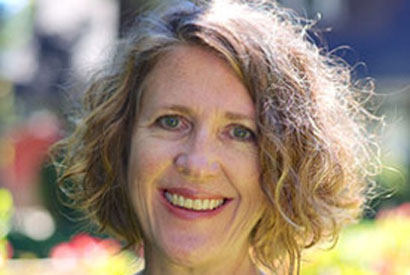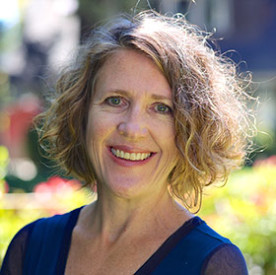A Q&A with Shannon Jackson
Longtime faculty member Shannon Jackson will serve as the campus's first associate vice chancellor of arts and design, beginning this fall. She shares her vision for UC Berkeley as an “arts research lab and arts engine" in a Q&A with the NewsCenter.

April 16, 2015
A faculty member in rhetoric as well as theater, dance and performance studies, Professor Shannon Jackson has been named as the campus’s first associate vice chancellor of arts and design, beginning this fall. In this Q&A with the NewsCenter, she shares her vision for UC Berkeley as an “arts research lab and arts engine.”
What are UC Berkeley’s strengths with regard to the arts?

Professor Shannon Jackson
Berkeley’s central strength lies in the talent it continues to attract. Despite state budget cuts, we have leading faculty artists in nearly every art field. We have a terrifically talented brain trust, matched by dozens of award-winning scholars and critics whose research focuses on the role of arts and culture throughout history and in various regions of the world.
Meanwhile, BAMPFA, Cal Performances and our arts departments and centers are able to attract internationally renowned artists to our campus. And every year we have a new crop of exceptionally talented students.
Are there missing elements you hope to address in your new position?
I think we can do a better job of communicating the centrality of the arts, design and creativity to our campus identity. And we can better coordinate the programming and initiatives of multiple arts and design units in order to strengthen the impact of each, and to secure more resources for everyone.
Of course, we also need to ensure that our students are learning with tools and inside facilities adequate to a 21st-century education in a world-class university. I want students to be aware of the wealth of creative possibilities available to them.
Describe your vision for arts and design at Berkeley.
I think that Berkeley can capitalize upon key cultural shifts and key domains at which we excel. We are different from most art organizations, museums, symphonies, theaters, and many other schools in the sheer range of art and design fields represented on this campus. As a result, our capacity to engage intermedial and interdisciplinary art-making and research is particularly strong.
Moreover, as a public university with a renowned history of social activism, we have a depth of experience and a unique role to play in teaching, producing and advocating for the public role of the arts in advancing equity and social justice.And given our incredible profile in science and engineering, our campus has a chance to advance and refine local and national collaborations around the arts and STEM fields (together often called “STEAM”).
What can Berkeley offer, in the arts and design arena, that other universities can’t?
Our agenda can differ from that of many other universities in our degree of engagement within our larger community, the Bay Area, capitalizing upon the Maker ethos of the region and the dynamic art and design community that is steadily migrating to the East Bay.
Mindful of our public role in co-sustaining the Bay Area ecology, the arts are a means of community engagement for us, not a means to build a gated community. That same sense of connection is key to advancing our global profile as well; the arts can provide an arena for bracing intercultural exchange and a creative bridge between the UC Berkeley campus and our many international partners.
Finally, these distinctive pursuits and opportunities should be an integrated component of our student experience, whether we’re providing students with their first encounters with new art forms, giving them access to the latest tools, exposing them to cutting-edge artists from around the globe, or enabling them to create their own new work.
What are some artistic collaborations or events on campus that exemplify what you’d like to foster in your new role?
I like two-fer, three-fer or four-fer projects – ones that combine great art-making with meaningful student experiences, feature the distinction of the faculty as artists and scholars, or provide a terrific opportunity for community engagement. Or that do all these things at once.
Students and community members regularly have the opportunity to connect with internationally renowned visiting artists on the Cal Performances stage, whether with the Vienna Philharmonic or with Alvin Ailey dancers. Recently, the Arts Research Center, which I direct, worked with the Berkeley Art Museum gallery space to stage an over-subscribed practicum on issues of economics and labor in the arts, for our Bay Area arts community, in collaboration with the online journal Art Practical.
Meanwhile, we can find two-fers and three-fers in every department and center this year. As just one example among many, think of the recent “Natural Frequencies” sound installation, celebrating the 100th anniversary of the Campanile – a novel collaboration among faculty from multiple campus units, including the seismology lab.
Some 1,200 artists visit this campus each year, and of course those visits are most meaningful when we can find resources allowing those artists to stay for longer. And there are ongoing programs offered every year on campus, from the music department’s Noon Concert series to the fabulous investigative photography exhibitions at the J-School.
It’s my hope that we can stabilize our resources and programming infrastructure so that we can offer such spaces of arts-based collaboration and connection for decades to come.
Related information: Shannon Jackson tapped as faculty leader for arts and design (NewsCenter article)